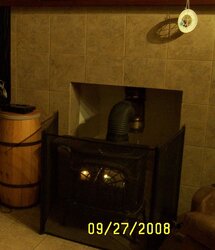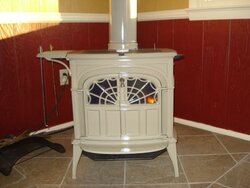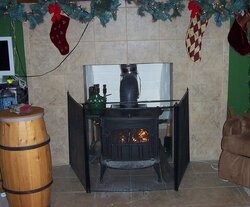Nice in white enamel, I like it. I think when I posted my pic, I was still burning candles in it during the warm months. I read the line about "Before anybody wigs out" then saw the proximity of the wooden barrel in my pic. I move that a little farther away when the thing is really firing. Here's a few hints that you can take or leave, after 10 years of Intrepid heating experience.
1) Burn candles inside, once or twice a month (in candle holders) during the summer and especially during rainstorms. It will dry up the humidity and moisture inside and keep rust from taking a stronghold. One summer it got so humid that the damper lever was actually frozen come winter. It freed up with a little effort, but burning candles stops stuff like that from happening.
2) Keep the ash fettles clear! This is probably tip numero uno. Intrepid comes with that slicer tool, which fits in beween the ash fettles in front. Once every 3 loads of wood or so, or whenever you see the ash rising, put on leather gloves, slowly open the front doors, and poke the ashes that accumulate in those "louvers" back into the stove. This is absolutely necessary for proper air into the fire, no matter what setting you are using. (Except open door burning) It also guarantees that you are helping to force the ash on the bottom grate down into the ash pan.
3) Buy good fireproof gloves and empty the ash pan when necessary. I heat-fractured the glass on my Intrepid a long time ago during a long, cold weekend when the coals built up past the fettles and against the glass. Stupid, but I was a novice, and I didn't even realize I could buy gloves protective enough to be able to handle the ash pan on a working stove. Even so, try to wait until the coals have mellowed a little, and even then you have to avoid flat surface contact like palm and fingers against the bottom of the pan - no good!
4) Lift off the griddle and get it out of your way when you are messing with the upper fireback during secondary combustion chamber cleanings. Work inside the stove. Move the tabs that hold the fireback from the inside of the stove with pliers, once you have slightly loosened the nuts on the outside. Have a flashlight handy. Get the manual. If they don't offer it anymore, I have one I can email to you. The hard part is getting everything in proper position and alignment, and then holding it there while you turn those tabs back into position to hold it. You have to a)make sure the damper and control rod are correctly positioned and the rod is sitting in that little groove, and then b) that all has to stay that way while you slip the fireback in, keeping the little protrusion on the bottom in back of the front firebrick.
5) The bottom grate just lifts right out. I owned the thing for years and never knew that. Pull out all the ash fettles one at a time, on an angle, and then lift the grate out. Get a good grip, it's heavy. Makes it really easy to clean out the ash that falls under the ash pan.
6) DON'T GET LAZY AND RE-LOAD THE STOVE WITH THE DAMPER IN THE SEC COMBUSTION POSITION. Yes it works fine if it's hot enough, but when you load the wood you run the risk of knocking against the damper and sending it slamming open. That's not good for the casting. It's like "slamming the slide" on a gun and it can possibly produce stress cracks.
7) CHANGE THE HANDLES. Sorry I waited for #7 for this, because I'm sure I lost a lot of readers to boredom by now. The ceramic handles on early (pre-1980) Intrepids are a liability and a burn hazard. Get the real deal, SS coil "springs". They are the only thing that really work, especially on that side damper control which gets very hot when you are using the "re-burn". And don't touch anything except the spring coils. Don't make the mistake of touching the bolt in the center. But if you're smart you won't even approach a working stove without work gloves.
8) Don't close the air inlet shutter all the way unless your stack is cherry. Once in awhile, when you start a fire with a lot of kindling, and then you get sidetracked, the draft makes a too-hot fire. Then, you throw the damper into "re-burn", close the air inlet, and in a minute or so you're right as rain. Other than that, you can damp it down to near closed when the fire is very hot, but don't close it all the way. Burn a little hotter, load a little more often, and keep the creosote down.
9) If you can still get the rear heat shield, go for it. It works amazingly well at increasing forward heat production. As you can see from my pic, I don't need it - I have mine stuck in front of a fireplace. But it does more than keep things in back from burning - it redirects a lot of heat to the front and to your room!
10) Work the fasteners once a year. One of the people in this thread found a new stove in shrink wrap. Crack and re-tighten the stove bolts that hold the a) reversible flue collar, and b) door glass and door heat shield. Clean off the rust and spray with WD-40 before replacing. Replace the stovebolts that hold the glass and door heatshield every few years. TAKE THE DOORS OFF and do it flat. Otherwise you risk dropping the glass. Get the PERFECT size phillips screwdriver, you don't want it slipping out and cracking the glass. The doors have 2 gaskets each and they will eventually need to be replaced.
If you are smart, you will buy some grade '8' hex bolts the same size as the stove bolts that are in the flue collar, and replace with them. GO EASY on the tightening! If you use a ratchet, just use three fingers. Snug ONLY. But this will save you so much nightmarish work, because the flue collar has a very important gasket that will eventually need replacing.




